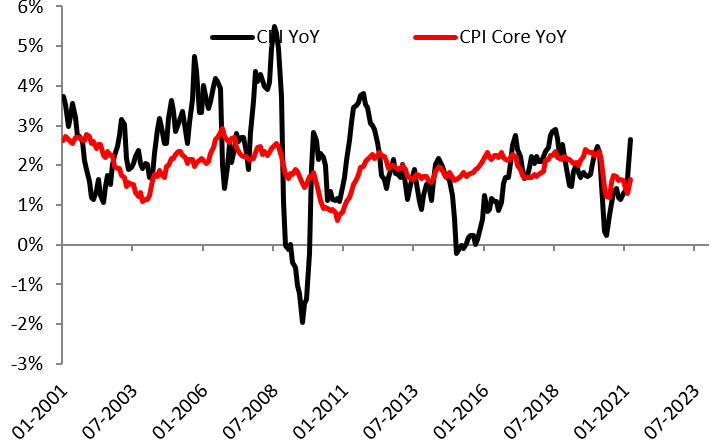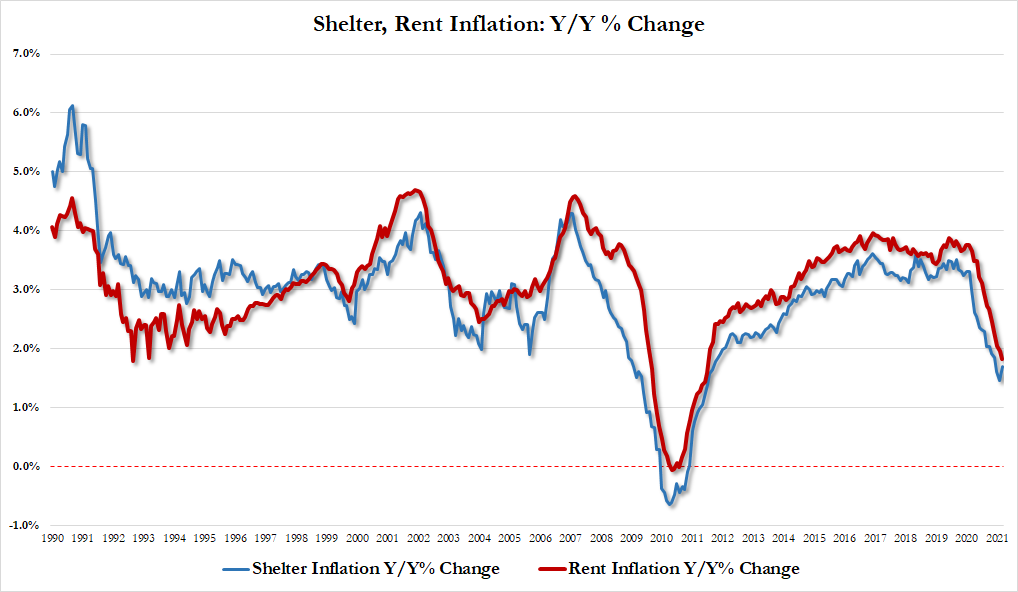- Another upside inflation surprise
- A surge in gasoline prices accounted for about half the gain
The annual inflation rate in the US surged to 2.6% in March from 1.7% in February, slightly beating analysts’ estimates of 2.5%. Today's reading was the highest since August of 2018. The biggest driver of the jump was in the energy sector: (13.2% vs 3.7% in February), namely gasoline (22.5% vs 1.6%), electricity (2.5% vs 2.3%) and utility gas service (9.8% vs 6.7%). Prices also accelerated for used cars and trucks (9.4% vs 9.3%), shelter (1.7% vs 1.5%) and new vehicles (1.5% vs 1.2%) while inflation slowed for medical care services (2.7% vs 3%) and food (3.5% vs 3.6%). The index for apparel fell 0.3 percent in March, following a 0.7 % decline the previous month. The education index also declined over the month, falling 0.2 percent. US core consumer prices, which exclude volatile items such as food and energy, increased 1.6 % year-on-year in March, following a 1.3 % gain in the previous month and above market projections of a 1.5% advance. On the monthly basis CPI increased 0.60 % in March over the previous month, the most since 2012. Higher in gasoline prices accounted for almost half of the advance. The core CPI excluding volatile food and energy components, rose 0.3 % from a month earlier, the most in seven months on rising rents and auto insurance cost.
 Today's reading showed the biggest MoM jump since June 2009 and biggest YoY jump since Aug 2018.Source: XTB, Macrobond
Today's reading showed the biggest MoM jump since June 2009 and biggest YoY jump since Aug 2018.Source: XTB, Macrobond
That big surge on a year-over-year basis was caused by the “base effect,” or the lower level used for comparison. In March 2020, the government had just begun a massive shutdown of U.S. businesses that ultimately would see more than 22 million Americans on the unemployment line. Also, rising commodities and material costs, coupled with supply constraints caused producer price inflation to reach a 10-year high of 4.2%. Meanwhile, ISM reports have shown that orders are close to their record highs, while customer inventories are at a record low. This suggests that firms have strong pricING power that could allow them to increase their profit margins after several years of margin compression, which could keep inflation higher for longer.
This, of course, contradicts the official stance of the authorities. Fed Chair Powell on Sunday and Biden administration economists on Monday, confirmed that while they expect a jump in inflation in the months ahead, the change could prove temporary due to comparisons with last year’s pandemic lockdowns and extra consumer spending from stimulus checks and pent-up demand.
It will be interesting to observe the housing component in the coming months as Primary rents and owners’ equivalent rent account for a third of the CPI basket. The shelter index rose 0.3% in March, with the index for owners’ equivalent rent and the index for rent both increasing 0.2 %. One year after the pandemic began, shelter inflation actually rebounded from 1.47% YoY in February to 1.70% YoY in March, the highest since 2020. Meanwhile, rent inflation continued to fade, and was up 1.83% in March, down from 1.96% in Feb, and the lowest since 2011. If the housing component continues to increase over the next few months, then inflation could remain around 3% for an extended period of time and could lead to interest rate hikes as early as the end of 2022, especially among strong economic growth and rapid job creation.
 Housing will be the component to watch in the coming months. Source: Bloomberg via ZeroHedge
Housing will be the component to watch in the coming months. Source: Bloomberg via ZeroHedge
Breaking: crude oil inventories above expectations 📌
Fed officials favor continued monetary easing 🔎
BREAKING: NATGAS declines after EIA data 📌
BREAKING: Eurozone trade balance mixed 💶


